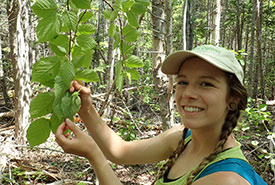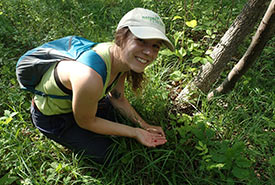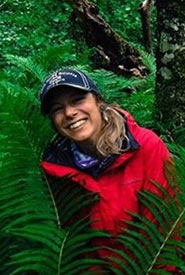Rediscovering food from our own backyards

Me holding a beaked hazelnut (Photo by NCC)
Another week has gone by, and the time has come where I look at my empty cupboards and realize that I cannot put off grocery shopping any longer. Grudgingly, I pack up my reusable bags and head across the street to the grocery store. I browse through the aisles of food, packaged neatly in boxes, bags and cans. Often, you can be fairly sure the raw ingredients aren’t locally sourced ― especially in a climate with a short growing season like in Nova Scotia. This makes me stop and ask myself, “What did our not-so-distant relatives do when they needed food, in a time before grocery stores existed?”
As a society, we tend to be distanced from our food. For most of us, we do not see first-hand where our food comes from. Instead, we merely walk or drive to the nearest supermarket and fill up a cart. For people who lived in Nova Scotia long before grocery stores existed, or even agricultural techniques were commonplace, it was essential to know how and when to collect and store food. Foraging was an essential skill to their livelihoods. They had to know the perfect time of year to scour fields, trees and shrubs to harvest edible fruits, vegetables and medicinal plants.

I stumbled across a patch of woodland strawberries (Photo by NCC)
I first became interested in foraging late last summer, after I purchased my first mushroom field guide by George Barron. I am far from experienced, and mushrooms are an area of foraging where it is important to be knowledgeable. So I spent my winter reviewing my guide book, hoping to gather some black morels and chanterelles this season. Though my interest started with mushrooms, I realized the foraging potential of our area when my aunt gave me a field guide on edible plants of Atlantic Canada for Christmas last year.
Fiddleheads, for example, are one of Nova Scotia’s most well-known and widely enjoyed local foraged food. Also, there are countless native plants with tasty berries that are perfect for jam or a sweet dessert (I am patiently waiting for late summer for the blueberries and huckleberries to ripen!). If you like a hot cup of tea with your dessert, you can head down to a bog and pick some Labrador tea. Even pesky invasive species can become tasty ingredients, with Japanese knotweed, dandelion and garlic mustard being edible examples.

Me checking serviceberries for ripeness (Photo by NCC)
My internship with the Nature Conservancy of Canada has allowed me to spend many hours in forests and fields and along coasts. Between my supervisors, co-workers and my trusty guidebooks, I have been given the opportunity to discover the crisp, refreshing taste of Indian cucumber-root, the spearmint flavour of teaberry and the tartness of bog cranberries. There is an untapped world of tasty, local options that Mother Nature provides for us in our own backyard.
I may not be quite ready to forage my meals for the week, but hopefully over the course of my internship I will learn even more about the edible plants of Nova Scotia. When the time comes again to go grocery shopping, maybe we can all think a little differently about where our food comes from.
(Remember: Think before you pick! Do your research and, if uncertain, ask a knowledgeable source before you eat any foraged food! Check whether the area permits foraging activities.)
The Conservation Internship Program is funded in part by the Government of Canada’s Summer Work Experience program.



